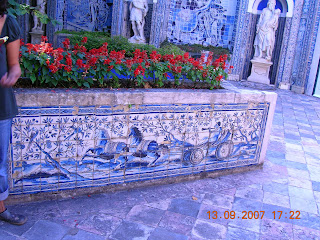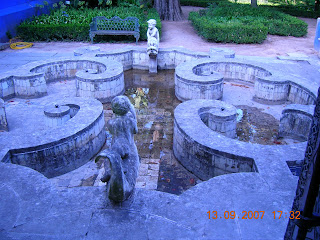
Visit to Museu do Azulejo (National Glazed Tiles Museum)
Definitely, the highlight of my time in beautiful Lisbon was the Glazed Tiles Tour arranged as an official Shore Excursion by TSS. Four TSS staff (Nikki, Grete, Rodrigo and I) and six female TSS students took the tour, which was billed thus:
“A Tile Expert will guide you through The National Glazed Tiles Museum to explore this art and its role in Portugal. The collection includes tiles from the 15th to the 21st century. After the tour develop your own skills in tile painting by participating in a hands-on workshop to create some glazed tiles to take home. Afterwards, you will have a chance to see some exemplary uses of glazed tiles around Lisbon. Travel back in time visiting the striking Convent of Madre de Deus and a Marquis Manor House, both covered in glazed tiles from the 18th Century.”
We rode in a van with a local driver and an enthusiastic and informative local guide. As we drove across Lisbon from the ship terminal to the Museum (officially Museu Nacional do Azulejo), she told us many interesting facts about Lisbon and its history. The museum, created in 1980, is housed in what was formerly the Madre de Deus (Mother of God) Convent, a Mannerist cloister from the 16th century.
Once at the museum, the guide was very informative about the art and craft of tile making, brought to Portugal by the Islamic Moors. The first displays in the museum showed the process of making tiles, the various types of tiles and how the designs changed over time. Islam forbids portraying the human form so originally the tiles had geometric designs and only later, after the Christians ousted the Moors (400 years before neighboring Spain did), representations of humans came into use. Blue designs on white backgrounds became common and from that came the term now used for glazed tiles in general is azulejos (from azure, meaning blue). The museum features tiles created between the mid-15th century and the present. Shown below are photos I took at the museum.
Tile Figures Outside Museum Restrooms 5851 

Colorful Tiles in a Carpet Pattern 5859

Tile Scene 2860

Typical Azulejo Wall Covering Tiles in Blue and White 5861

Blue, White and Gold Tiles –Typical Muslim Colors 5862

Green Tiles 5881

Glazed Bowl with Ducks 5882 (not a tile but very cool!)

View of Old Lisbon in Tiles 5883

Modern Tile 5884

Tile Picture 5886

Modern Owl Tiles 5887

Pre-Earthquake Lisbon 5892

At the mid-point in our museum tour, we were led into an open hallway that was part of a cloister where our two work tables, covered with white paper, were setup. For each two chairs was a small water dish surrounded by smaller dishes of liquid tile glaze in various colors. At each place was a 14x14cm glazed white tile and a paint brush with a narrow, blunt end. Each table had several small white cloth pouches filled with charcoal sitting in a small bowl. The museum tile artist was there to assist us. She said we could either do a free-hand design or use their templates, which she handed out. The templates were of still paper the same size and shape as the tiles and had small holes punched in them that formed the outline of a design. To use them, we placed the template exactly on top of the tile and rubbed a charcoal pouch over it, then carefully lifted the template off the tile to reveal a dot-to-dot type outline of the desired design to guide us as we applied the glazes.
Most of us chose templates to use but one Chinese student formed the Chinese characters for “Ant” out of ant-shaped figures. It was very clever and cute. I chose a fort template because when I think of Portugal, I think of medieval fortresses. No one else in the group understood my choice until later in the week when everyone had visited several historic forts and then they “got it.” I used mainly the traditional cobalt (dark blue) glaze on my tile, except for the tree, which had a brown trunk and light green top, and colorful flowers in each corner. I wrote “Portugal” on mine so I’d always remember. The area where we were was part of the museum viewing space and other visitors passed us as we worked, usually stopping to watch the process and comment. Probably some took pictures, too, but I was too engrossed to notice.
Some of the other tile designs chosen were: sailboat (Grete), elephant (Rodrigo), flower (Nikki), rooster (Chinese student whose mother was born in the year of the rooster). We talked and enjoyed each other’s company as we worked. Even our guide made a tile, too. The fired and finished tiles were delivered to us onboard TSS the day we left.
Open Cloister, 2nd Level (Later Our Tile Creation Place) 5864

Tour Guide, Wearing Green Top, and Other Tour Participants 5865
 Buveh Painting Tile 5874
Buveh Painting Tile 5874

Gold Leaf Covered Pulpit in Convent Church; note tile murals on either side 5896
Next we went boarded the van and headed north to the Marquis Manor House mentioned in the tour description and saw numerous examples of tile decorations both inside the house and in numerous forms in the expansive garden and grounds surrounding it. Animal figures doing “human” activities was the theme of many tile murals along the outdoor walkway. Seeing everything was an incredible experience. We were not allowed to take photographs inside the house.
Home of the Marquis de Fronteira (Palacio Fronteira) 5898
Tile Decoration on Front Porch 5899
View of Garden with Maze, Tile Walls, Reflective Pool and Statuary 5902

Closer View of Tile Walls 5914



Ornate Reflective Pond with Tile-Covered Gazebo 5906

Close-up of pool
Sea Life Detail on Pond Walls 5911

Animal Music Lesson Tile Mural 5908
How Tiles Came Into Prevalent Use in Lisbon
After much of Lisbon was destroyed in 1755 by an earthquake immediately followed by a tsunami and fires, tiles were designated as the primary mode of decorating both inside and outside of new structures. Even today, many, many buildings have beautiful tiles on the outer walls as well as tile decorations inside. Below are photos of tiles I took in various places in and around Lisbon.
Tiles with Lovely Colors 5809

Traditional Blue, White and Gold Colors 5822

GREEN Tiles 5829
Tile Walled Buildings 5830


Buveh beside Tile Mural of Jacob (Israel) being shown Joseph’s bloody garments (Sao Jeronimo’s Cathedral) 5990
Building in the Alfama area of Lisbon 6236
Tile Detail, Building in Alfama
Tile Wall of Building in Alfama 6244













No comments:
Post a Comment